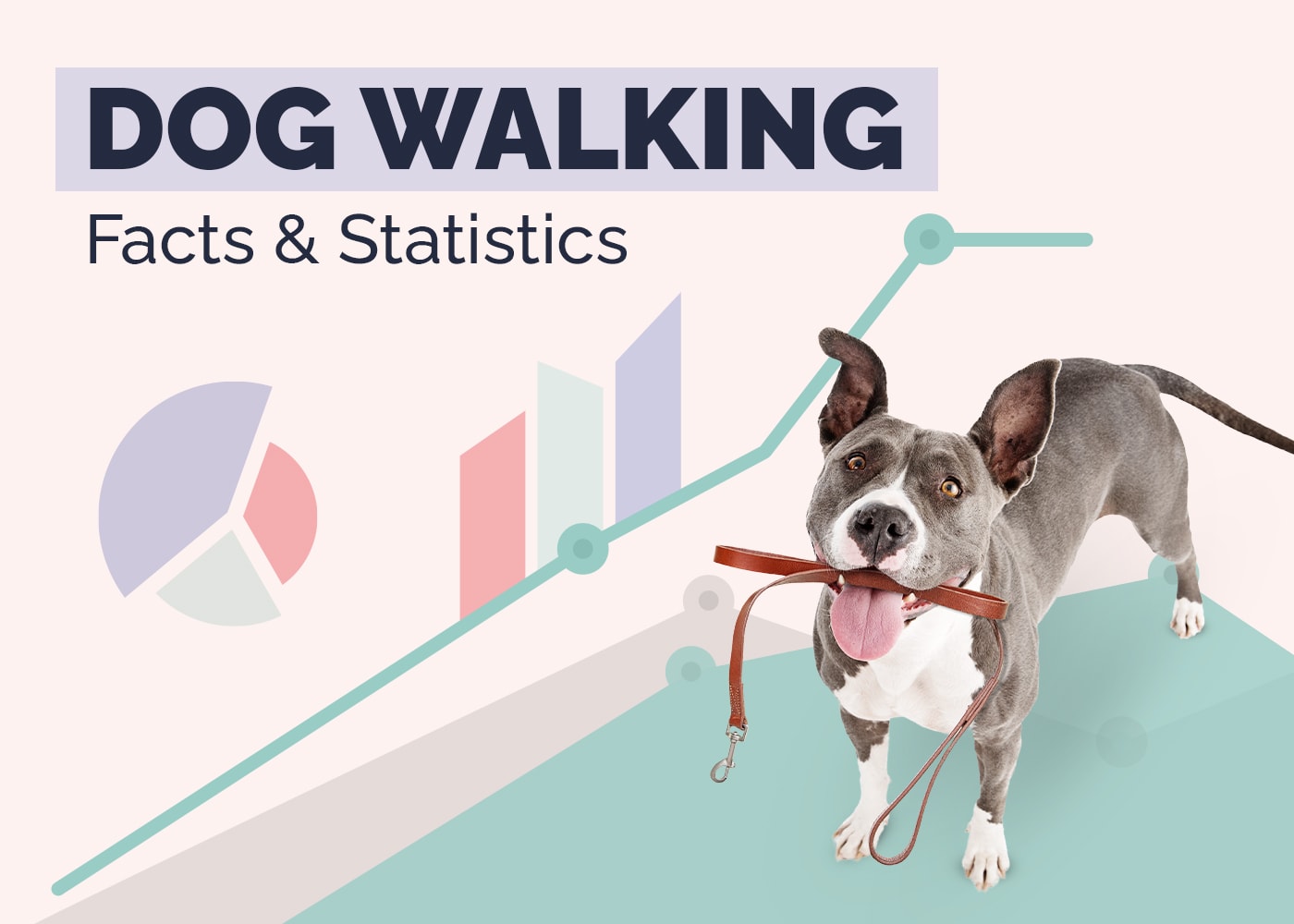12 Dog Walking Statistics & Facts to Know (2024 Update)

Updated on

Click to Skip Ahead
Note: This article’s statistics come from third-party sources and do not represent the opinions of this website.
Dogs are an essential part of many people’s lives and families. One way that many owners love to bond with their dogs and get exercise is through walking. However, some may not have the daylight hours to take their dogs for a walk, which is where dog walkers come in. There are a lot of interesting stats concerning dog ownership and dog walking, so read on to learn more!
The 12 Dog Walking Statistics
- There are 69 million US households that own a dog.
- COVID-19 led to around 30% of Americans adopting a pet.
- 2021 saw $9.5 billion spent by pet owners in the US on services like professional dog walking.
- Based on multiple studies, between 30–60% of dog owners don’t regularly walk their dogs, with an average of 41%.
- On average, a pet dog is walked nine times per week for around 34 minutes.
- 64% of dog owners believe that walking their dog is a direct reflection of the affection and love they have for their dog.
- 57% of dog owners who say they walk their dog admitted to having skipped at least one walk per week for some reason.
- A dog walk is rarely straightforward! On average, a single dog walking trip will encounter other dogs four times.
- In 2023, the professional dog walking space saw 0.3% growth.
- The current US professional dog walking market size is $1.3 billion.
- The number of dog walkers in the US had a 5.3% growth in 2023.
- In 2024, professional dog walkers will be paid $596.6 million.

Dog Ownership Stats
1. There are 69 million US households that own a dog.
(Bankrate)
The American Pet Products Association performed a survey that showed that 70% of American households own a pet. Of those, 69 million households own a dog, while only 45.3 million households reported owning a cat.
2. COVID-19 led to around 30% of Americans adopting a pet.
(Bankrate)
During the COVID-19 pandemic, around 30% of Americans introduced a new pet to their home. Of those pets, 20% were a dog or a cat.

3. 2021 saw $9.5 billion spent by pet owners in the US on services like professional dog walking.
(APPA)
Overall, in 2021, Americans spent $123.6 billion on their pets. Of that, $9.5 billion was spent on non-veterinary services. These services include professional dog walking, grooming, pet sitting, and pet insurance.
Personal Dog Walking
4. Based on multiple studies, between 30–60% of dog owners don’t regularly walk their dogs, with an average of 41%.
(Psychology Today)
Multiple studies from 2010–2019 in the US, UK, and Australia found that an average of 41% of dog owners said they don’t regularly take their dogs for a walk. Dog walking can be physically and emotionally beneficial for dogs and humans, which means this is a missed opportunity for many dog owners.

5. On average, a pet dog is walked nine times per week for around 34 minutes.
(Psychology Today)
When a dog is walked for 34 minutes, the walk covers close to 2 miles. In total, the average dog is walked for 11 full days every year and covers 870 miles. In that distance, you would only be 3 miles short of walking from New York City to Atlanta, Georgia!
6. 64% of dog owners believe that walking their dog is a direct reflection of the affection and love they have for their dog.
(Psychology Today)
Not only did 64% of dog owners say they believed walking their dog was a direct reflection of their feelings for their dog, but 78% of dog owners said they believed dogs should be taken for a walk twice daily.

7. 57% of dog owners who say they walk their dog admitted to having skipped at least one walk per week for some reason.
(Psychology Today)
There are several reasons that people miss walking their dogs. Of those who said they had skipped walks, 56% cited weather conditions, 32% cited their job, 31% said it was because of difficulties related to handling their dog, 24% cited family, and 32% admitted to feelings of laziness.
8. A dog walk is rarely straightforward! On average, a single dog walking trip will encounter other dogs four times.
(Psychology Today)
You’ll likely encounter other people walking their dogs four times on every dog walk. Approximately 50% of encounters with other people will include a short stop for a conversation. On top of all of this excitement, the average dog walk includes the dog jumping up on someone once and the dog’s leash requiring detangling from posts, trees, and other dogs’ leashes.

Professional Dog Walking
9. In 2023, the professional dog walking space saw 0.3% growth.
(IBISWorld)
This industry has seen relatively consistent growth in the past 10 years, averaging 1.8% yearly growth between 2017 and 2022. Its growth rate has been faster than that of the overall Consumer Goods and Services market sector. However, growth slowed in 2023, with a 0.3% growth rate.
10. The current US professional dog walking market size is $1.3 billion.
(IBISWorld)
This valuation is significantly higher than the market size in 2021. In 2021, the US dog-walking market was $979.2 million, while in 2022, it was just over $1 billion.

11. The number of dog walkers in the US had a 5.3% growth in 2023.
(IBISWorld)
The 5.3% growth in the number of professional dog walkers in the US led to 63,412 professional dog walkers actively working in the US in 2023.
12. In 2024, professional dog walkers will be paid $596.6 million.
(IBISWorld)
Although the dog walking market is valued at over $1.3 billion, only $596.6 million of that has been paid toward the wages of dog walkers. This means that the rest has gone toward things like insurance, supplies, and marketing.

Frequently Asked Questions
Are some dogs less likely to be taken for walks?
Yes. Small dogs weighing less than 30 pounds are less likely to be walked than their larger counterparts. Older dogs and dogs with obesity and other medical conditions are also less likely to be walked than younger, healthier dogs. Most dogs can benefit from walking, but it’s important to talk to your dog’s vet before beginning a walking regimen.
Is walking necessary for my dog’s health?
No. While taking your dog for a walk can have health benefits, there are other activities that your dog may enjoy participating in. Canine sports, like agility and obedience, running, swimming, and hiking, are all activities that many dogs enjoy doing. Just talk to your vet to ensure your dog is healthy enough for activity before starting any of these activities.

How can walking my dog improve my health?
Studies have shown a clear link between pet ownership and enhanced health for humans. On top of that, regular walking and other aerobic and low-impact workouts also help improve your health. Regularly walking or playing with your dog is shown to help reduce blood pressure, cholesterol levels, and triglyceride levels.
Spending time with your dog may also help to reduce the symptoms associated with depression, anxiety, and PTSD, and it can lead to better cognitive function in older people, as well as increasing opportunities for socialization and decreasing feelings of loneliness. (CDC)
Is it easy to find a dog walker?
Depending on where you live, dog walking services may be more or less accessible. The largest concentrations of professional dog walkers live in New York City and Chicago, Illinois. Make sure to check the credentials and experience of any dog walker before allowing them to walk your dog. (ZIPPIA)
Are dog walking jobs evenly split between men and women?
The professional dog walking industry is predominantly populated by women, accounting for 70.8% of dog walkers, while men only account for 29.2%. It may be difficult to find a male dog walker if your dog isn’t comfortable with females. Interestingly, male dog walkers make around $700 per year more than female dog walkers. (ZIPPIA)

Conclusion
Taking your dog for a walk can benefit you and your dog, as well as helping to grow the trust and relationship between you. Sometimes, you may not have the time or ability to take your dog for a walk. Because of that, professional dog walking services have become the norm for many dog owners.
Always talk to your vet before beginning a walking program for your dog if they have not had much activity, are elderly, or have any injuries or medical conditions. Also, check the references and credentials of the dog walker you choose.
Featured Image Credit: Piqsels











